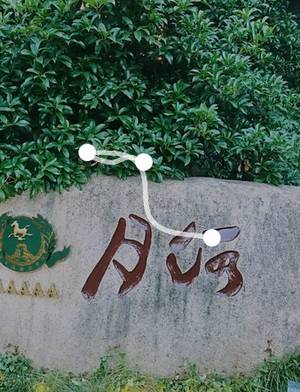Experience the fairyland of Taoyuan in Wulei Mountain, Cixi
1 cities |
8 attraction(s) |
total distance 160
km
 TIPS
TIPS
Day1
Day2
Day1: Ningbo
5 attraction(s) ·
159 km
1
Restaurants in the scenic area have high prices and small portions. The service is average, and you can watch the ingredients being ordered in the ordering room. The tables outside have good air quality. The grilled fish is served cold and doesn't look very appealing, but the taste is okay. A small plate of river shrimp costs 68 yuan, which is a bit expensive, but the shrimp is fresh. Stir-fried rice cakes can be eaten as a main dish, but they are slightly salty. The minced meat and eggplant dish and the clam and pickled vegetable soup taste good.
1
km
2
Minghe Ancient Town is located in the southeastern part of Cixi, Ningbo, Zhejiang Province, 50 kilometers east of Ningbo. It was built during the Tang Dynasty and has a history of more than 1200 years. It is one of the ancient towns in the Three North and One Belt. Minghe Ancient Town is built along Baiyang Lake and adjacent to the Wulei Mountain Scenic Area, making it a true landscape ancient town. There are seven ancient bridges from the Ming Dynasty crossing the rivers in the town, and along the river, there are characteristic Ming and Qing Dynasty residences of the southern water towns, most of which are luxury houses built by the Ye family after they became wealthy from the pharmaceutical industry. The Salt Warehouse Walking Horse Building is a unique ancient building in the courtyard group in the southern part of China. In the Shen's Old Residence, there are still the good news of their offspring being successful in the imperial examination and the lingering atmosphere of books, which is the witness of the accumulation and continuation of the ancient town's culture. The Wulei Temple, the oldest ancient temple in East Zhejiang with a history of more than 1700 years, and Jinshan Temple, built during the Liang Dynasty, are both near this town, accompanied by the morning bells and evening drums of the temples and the melodious chanting.
79
km
3
Duhu and Baiyang Lake are actually only 200 meters apart. Duhu is in the east and Baiyang Lake is in the west, so some people call them "sister lakes". If you go west along Baiyang Lake, you will find that Shanglin Lake is not far from Duhu and Baiyang Lake, separated by a few mountains. It's truly a beautiful harmony!
79
km
4
The restaurant is located near Baiyang Lake in Minghe Ancient Town. The environment is alright and the dishes taste good. The deep-fried black sesame and lard dumplings, grilled yellow croaker, pickled vegetable yellow croaker soup, pickled vegetable bamboo shoots, are all authentic Ningbo dishes, and they are quite delicious!
1
km
5
Day2: Ningbo
3 attraction(s) ·
2 km
1
Wulei Mountain Scenic Area is a national 3A-level tourism scenic area and a provincial-level scenic spot in Zhejiang Province. It is a tourist attraction with the characteristics of Buddhist culture and natural beauty. It is located in Guanhaiwei Town, Cixi, with convenient transportation, only 10 kilometers away from the exit of Shenhai Expressway. The scenic area consists of three scenic spots: Wulei Temple, Lotus Garden, and Zangyun Stream. Its four main features are ancient temples, clear lakes, secluded valleys, and clear streams. The spiritual Wulei Mountain will surely leave you with the realization of "feeling as if you are in a paradise, separated from the mundane world and the bustling crowd".
1
km
2
The farm in the scenic area has a nice environment and a variety of dishes, especially the homegrown ones, and the prices are quite affordable.
1
km
3
Lingshan Temples in Cixi are famous, with Five Lei Temple being the most renowned. It is located on the east side of Duhu Lake, opposite Jin Xian Temple. One side faces the vast lake, while the other is surrounded by towering mountains. The rich Buddhist culture adds a peaceful atmosphere to this scenic spot, earning Five Lei Temple the title of the oldest temple in Zhejiang Province. Legend has it that 2,000 years ago, Indian monk Naroyan visited famous mountains and scenic spots in China and chose the Fengshui treasure land on Five Lei Mountain. He settled there, lit a bonfire, and attracted followers. The day the roaring fire rose was the beginning of cultural exchange between China and India. However, despite the blazing holy fire, there were few who responded, and it was difficult to find like-minded people due to the distance between mountains. It is said that one day, Sun Quan's mother passed by in a boat and noticed the faint fire. She ordered someone to investigate and learned the story. She then ordered the construction of a small temple at the spot where the holy fire was rising, which was probably the predecessor of Five Lei Temple. With this small temple, Naroyan finally ended his years of rough living. Five Lei Temple has many ancient relics and scenic spots, including a water pond named "Zhenming Pool" in front of the temple. Clear water flows from the Elephant Eye Mound in the east and enters Zhenming Pool, then flows through a small channel to Moon Lake, never running dry. It is said that Naroyan personally led his disciples to excavate it day and night, encountering demons and causing casualties. Therefore, it is also called the "Miraculous Pool." The water in the pool is clear and refreshing and is believed to help cure illness and ward off evil. There are also five red pine trees next to the pool, known as the fragrant wood of Five Lei Temple, planted by later generations. On the nearby slope not far from the temple, there are several towering ancient trees that are difficult to estimate in age and require several people to hug. The temple is mostly inhabited by camphor trees, with lush foliage and evergreen all year round, creating a harmonious contrast with the golden buildings of Five Lei Temple. In the first year of the Wendeyuan period in the reign of Emperor Xizong of the Tang Dynasty (888 AD), the scale of Five Lei Temple was greatly expanded. Various pavilions and towers were exquisite, and halls and pavilions were in abundance. It was truly a "ancient temple with high towers to avoid the summer heat, with pine and cypress creating a cool atmosphere on sunny days." Literary figures from various dynasties have also left numerous beautiful poems and lyrics about Five Lei Temple. For example, Shu An, a poet from the Song Dynasty, wrote in his poem about visiting Five Lei Temple: "Five Lei Peak pierces the sky with its height, ancient trees embrace each other for thousands of years. Dust floats as if not of this world, the wind falls softly near the moon." In order to provide a resting place for pilgrims, an annex was set up at the stone channel at the edge of Duhu Lake by Five Lei Temple. It is specifically for visitors who come up or down the mountain to take a short break. In the early 1930s, Master Hongyi, the 11th generation founder of the Lv Sect, stayed here and established the "South Mountain Buddhist School." However, due to disagreements, the school was not successful. Nevertheless, Five Lei Temple became the birthplace of the Tiantai Sect in the Ningbo area, indicating its far-reaching influence. After the founding of Zhejiang East District Party Committee in Mijiadai in 1942, Tan Qilong, He Kexi, and others led anti-Japanese fighters to hold meetings, rest, and formulate strategies to lead the people of Zhejiang East to resist the Japanese. The battles in the Northern Three Provinces made the enemy fearful. After liberation, the monks in the temple always enjoyed recounting this history. According to Ven. Zhenru, the abbot of Five Lei Temple, the temple receives over 200,000 visitors each year. Although there is a winding mountain road that leads directly to Ningbo for transportation, most people still prefer to walk as a sign of their sincere faith. The newly restored Five Lei Temple has now officially changed its name to "Wu Lei Lecture Temple". These four powerful characters were personally inscribed by Mr. Zhao Puchu, adding a new landscape to Five Lei Temple.

























